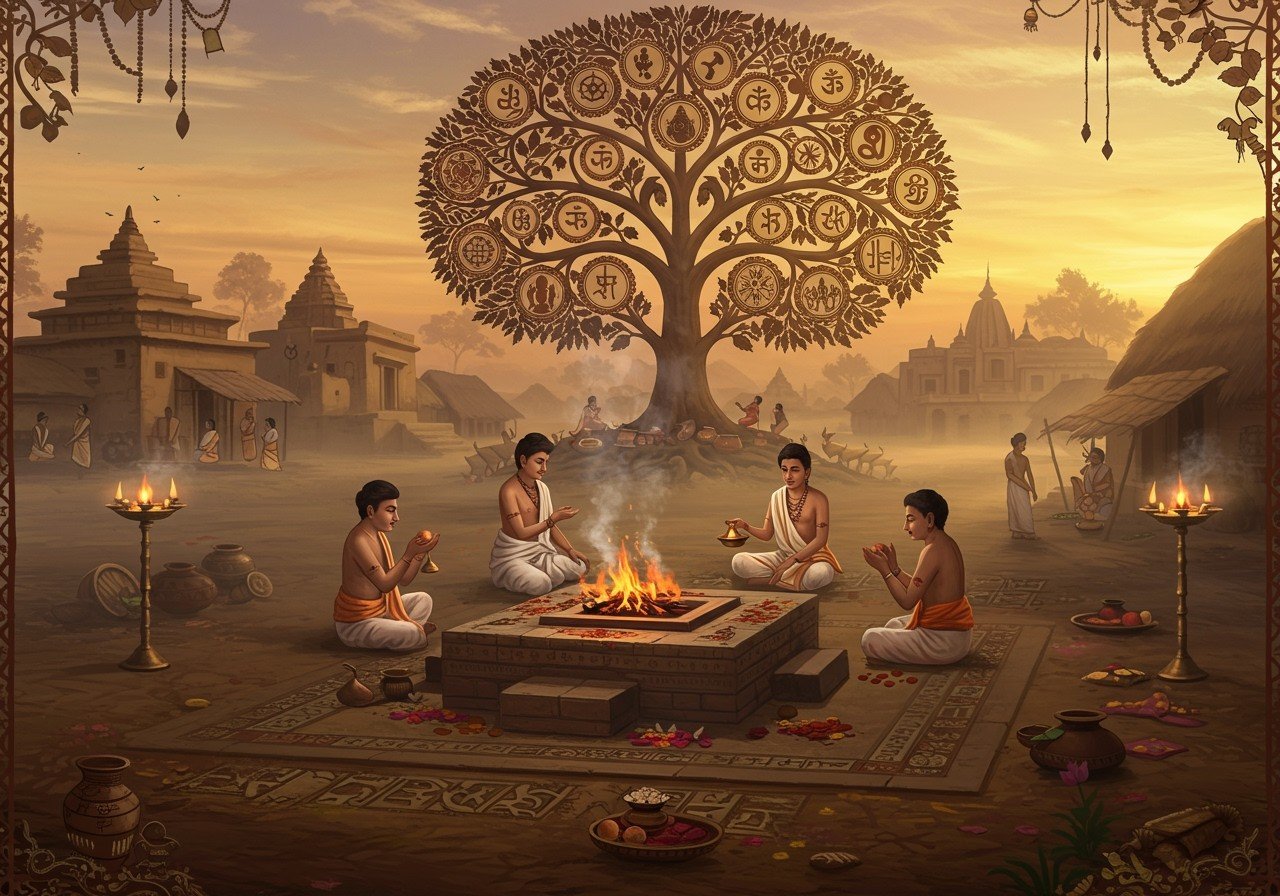
Pre-Mauryan India, the era preceding the Mauryan Empire, was a period of diverse spiritual beliefs and practices. This era witnessed the development of various religious and philosophical traditions that continue to influence Indian spirituality today. Understanding this period offers valuable insights into India’s rich cultural and spiritual heritage.
Vedic Religion and Rituals
The Vedic religion significantly shaped Pre-Mauryan India’s spiritual landscape. Centered around elaborate rituals and hymns dedicated to deities like Agni (fire god) and Indra (god of thunder), Vedic practices were documented in the Samhitas, collections of mantras in archaic Sanskrit. The Rigveda, dating back to the Rig Vedic period, stands as the oldest of these texts, containing 1028 hymns that formed the basis of early Aryan religious practices.
Yajnas, intricate fire rituals, were central to Vedic practices, invoking divine blessings and maintaining Rta, the cosmic order. Brahmins, the priestly class, played a crucial role as custodians of these rituals, ensuring the prosperity and social harmony of the community through sacrificial ceremonies.
Significance of the Four Vedas
- Rigveda: The oldest Veda, comprising hymns praising various deities, providing a glimpse into the early Aryan worldview.
- Yajurveda: This Veda outlines the procedures and instructions for performing rituals and ceremonies, essential for maintaining religious order.
- Samaveda: Containing melodic chants and hymns, the Samaveda added a musical dimension to Vedic rituals, enhancing their spiritual impact.
- Atharvaveda: This Veda encompasses spells, charms, and incantations, reflecting a more practical and mystical aspect of Vedic traditions.
Emergence of Upanishads
The Upanishads marked a philosophical shift from ritualistic practices toward introspective spirituality. Introducing concepts like Brahman (universal soul) and Atman (individual soul), these texts emphasized self-knowledge and realization. This philosophical development signaled an evolution in ancient Indian thought, contrasting with the outward focus of Vedic rituals.
Key Upanishadic Teachings
- Moksha: The concept of liberation from the cycle of rebirth, achieved through self-realization and understanding of Brahman and Atman.
- Interconnectedness: The Upanishads emphasized the interconnectedness of all beings, promoting a sense of unity and universal consciousness.
Meditation and contemplation became central practices, guided by gurus who mentored disciples on their spiritual journeys.
Rise of Other Religions
Alongside the Vedic traditions and Upanishads, other religions emerged and played significant roles in shaping the spiritual landscape of Pre-Mauryan India. These included:
- Hinduism: Evolving from Vedic foundations, Hinduism incorporated diverse deities, philosophies, and practices, becoming a major religious force.
- Buddhism: Founded by Siddhartha Gautama (the Buddha), Buddhism emphasized the Four Noble Truths and the Eightfold Path as a means to achieve enlightenment and liberation from suffering.
- Jainism: Founded by Mahavira, Jainism stressed non-violence (ahimsa), asceticism, and the pursuit of spiritual liberation through rigorous self-discipline.
- Saivism and Vaishnavism: These devotional traditions, centered around the worship of Shiva and Vishnu respectively, gained prominence during this period, contributing to the diversity of religious expression.
Rise of Jainism
Jainism, founded by Mahavira, emerged as a prominent religious movement in Pre-Mauryan India. Its core principles of Ahimsa (non-violence) and rigorous self-discipline resonated with many, offering a distinct path to spiritual liberation.
Core Principles of Jainism
- Non-violence (Ahimsa): The central tenet of Jainism, emphasizing the avoidance of harm to all living beings, influencing ethical and social conduct.
- Truthfulness: Adherence to truth in thought, word, and deed, promoting integrity and honesty in all aspects of life.
- Non-stealing: Respect for the property of others, emphasizing ethical acquisition and renunciation of material possessions.
- Celibacy (Brahmacharya): Practicing celibacy as a means of self-control and detachment from worldly desires.
- Non-possession (Aparigraha): Minimizing material possessions and attachments, fostering a life of simplicity and detachment.
Tirthankaras, spiritual teachers, guided followers towards liberation, while asceticism became a key practice for achieving spiritual purity. Jainism significantly influenced the socio-cultural fabric of ancient India.
Connecting with Pre-Mauryan Spirituality Through Poojn.in
Poojn.in, India’s leading cultural goods and services store, offers a wide selection of products to help you connect with the spiritual heritage of Pre-Mauryan India. Explore our collection:
- Bel Malas: Similar to those used in ancient times, these malas are perfect for meditation and chanting, enhancing your spiritual practice. Available in various sizes and styles.
- Incense Sticks: Create a sacred atmosphere with authentic Indian sandalwood incense, reminiscent of ancient rituals and ceremonies. Choose from a variety of fragrances.
- Shiva Lingams: Honor Lord Shiva, a prominent deity in Pre-Mauryan traditions, with beautifully crafted Shiva Lingams for your personal altar or shrine. Made from various materials.
Visit www.poojn.in today to discover more authentic products and deepen your connection to ancient Indian spirituality. We offer secure pan-India delivery.
Conclusion
Pre-Mauryan India’s spiritual landscape was a tapestry of diverse beliefs and practices. From the Vedic rituals to the philosophical insights of the Upanishads and the ethical teachings of Jainism, this era laid the foundation for India’s rich spiritual heritage. These traditions, emphasizing harmony, introspection, and non-violence, continue to inspire and guide spiritual seekers today. By understanding and embracing these ancient teachings, we gain a deeper appreciation for our roots and the profound wisdom of the past.
FAQs
What were the primary spiritual practices in Pre-Mauryan India? Rituals, sacrifices, meditation, chanting, daily worship (puja), and observing festivals and fasts were common spiritual practices during this period.
How did animism influence Pre-Mauryan beliefs? Animism, the belief in spirits inhabiting natural elements, led to the worship of nature spirits, animals, and plants, reflecting a reverence for the natural world.


